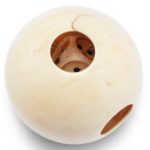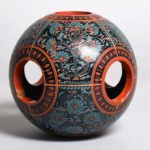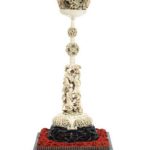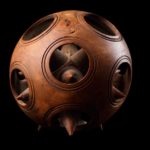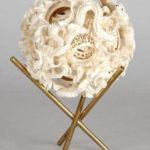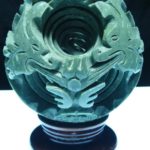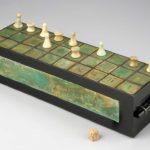Puzzle balls or devil’s work balls originated in China and were usually carved from bone or ivory. They are very intricate and consist of concentric hollow spheres carved from a single solid block that fit within one another in a way that looks impossible. [1]
While Chinese puzzle balls are very intricate, European ones tend to have smooth surfaces.
Below are some examples and price guides of puzzle balls including a 19th Panjab ball and a large canton ivory ball with it’s stand.
GERMAN, LATE 17TH / EARLY 18TH CENTURY | AN IVORY PUZZLE BALL
Sold for 2,772 EUR at Sotheby’s in 2020
Puzzle Ball 19th century (made)
Hollow red blue & black; Games, wood, lacquered pierced, Panjab, C19
Reference: © Victoria and Albert Museum
A LARGE CANTON IVORY PUZZLE BALL AND STAND 19th century The reticulated ‘puzzle’ ball with multiple pierced layers and with peony flowers to the exterior, seated upon a tall elaborate stand with a further ball and a figural diorama of the Eight Immortals, wood stand. 50cm (19 5/8in) high
Sold for £ 5,000 inc. premium at Bonham’s in 2017
GERMAN, 17TH CENTURY A puzzle ball boxwood; with twelve apertures containing a moveable spiked twelve-pointed boxwood star 23⁄8 in. (6 cm.) diameter
Sold for GBP 5,625 at Christie’s in 2020
Chinese Carved Ivory Puzzle Ball With dragon motifs, gilt-metal tripod stand. Diameter 4 inches.
Sold for $540 (includes buyer’s premium) at Doyle in 2006
LARGE JADE 8 LAYER DRAGON PUZZLE BALL SPHERE
THIS WONDERFUL PIECE OF WORK IS MADE OF REAL JADE. IN ONE PIECE OF SOLID JADE, THERE ARE TOTAL OF 7 BALLS INSIDE. ALL BALLS INSIDE ARE MOVABLE INDIVIDUALLY
Sold for $120 at U.S. Auction Gallery in 2021
[1] Wikipedia
